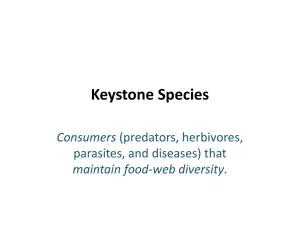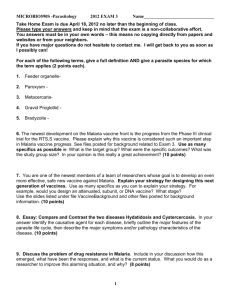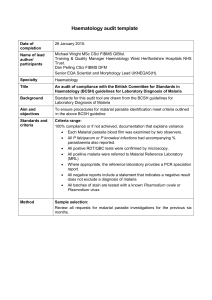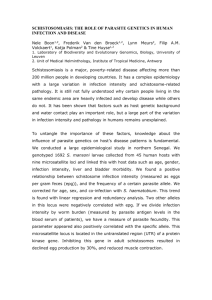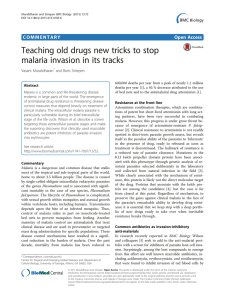Microbiology 51 [9-2
advertisement
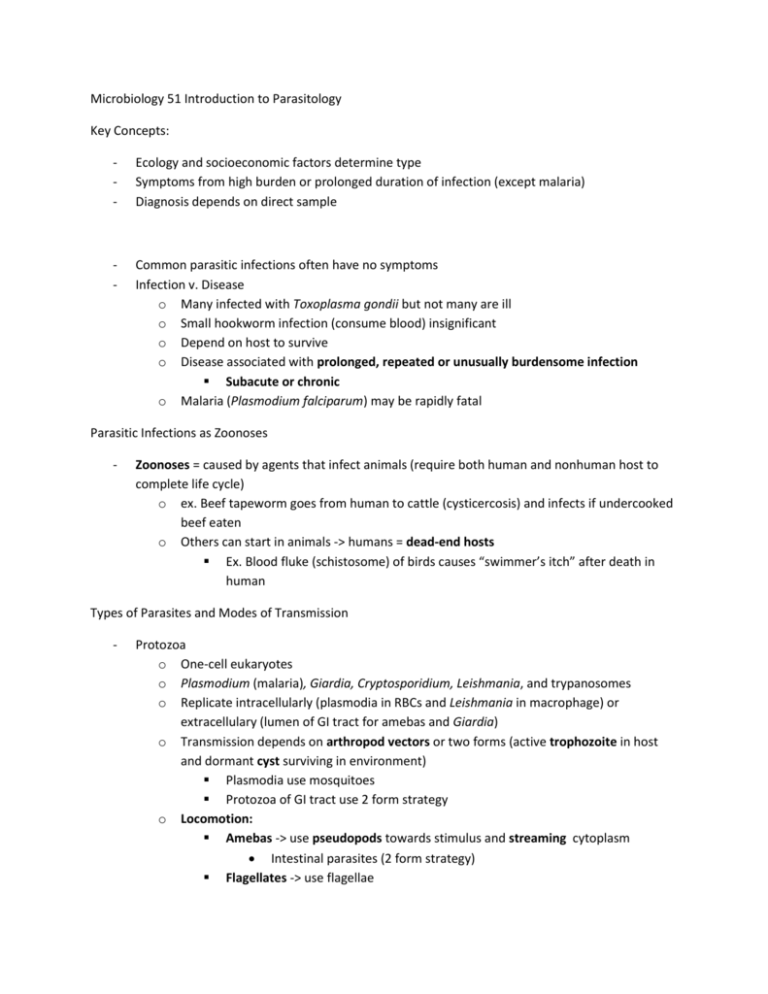
Microbiology 51 Introduction to Parasitology Key Concepts: - Ecology and socioeconomic factors determine type Symptoms from high burden or prolonged duration of infection (except malaria) Diagnosis depends on direct sample - Common parasitic infections often have no symptoms Infection v. Disease o Many infected with Toxoplasma gondii but not many are ill o Small hookworm infection (consume blood) insignificant o Depend on host to survive o Disease associated with prolonged, repeated or unusually burdensome infection Subacute or chronic o Malaria (Plasmodium falciparum) may be rapidly fatal Parasitic Infections as Zoonoses - Zoonoses = caused by agents that infect animals (require both human and nonhuman host to complete life cycle) o ex. Beef tapeworm goes from human to cattle (cysticercosis) and infects if undercooked beef eaten o Others can start in animals -> humans = dead-end hosts Ex. Blood fluke (schistosome) of birds causes “swimmer’s itch” after death in human Types of Parasites and Modes of Transmission - Protozoa o One-cell eukaryotes o Plasmodium (malaria), Giardia, Cryptosporidium, Leishmania, and trypanosomes o Replicate intracellularly (plasmodia in RBCs and Leishmania in macrophage) or extracellulary (lumen of GI tract for amebas and Giardia) o Transmission depends on arthropod vectors or two forms (active trophozoite in host and dormant cyst surviving in environment) Plasmodia use mosquitoes Protozoa of GI tract use 2 form strategy o Locomotion: Amebas -> use pseudopods towards stimulus and streaming cytoplasm Intestinal parasites (2 form strategy) Flagellates -> use flagellae - - - If intestinal, 2 form strategy. If tissue or blood, arthropods Ciliates -> covered in cilia; unusual Apicomplexans (sporozoa) -> use “tractor-tread” gliding motility malaria, toxoplasmosis Intracellular replication Helminths o Worms are multicellular animals (metazoa) o Reproduce sexually (male and female worms) Some are hermaphroditic o Roundworms -> circular; no visible body segmentation Ex. Ascaris lumbricoides o Flatworms -> asymmetric Flukes (Schistosoma, Fasciola): short and nonsegmented Tapeworms: segmented, generate from worm head that makes chain (each seg w/ own organs) o Typically extracellular and have cuticle Larvae of Trichinella spiralis (trichinosis) and tapeworms are dormant cyts o No helminth completes life cycle in single human Parasitic burden causes disease Vectors o Transmitters of disease (parasites, bacteria, and viruses) o Most are arthropods Ex. Anopheles mosquito (transmits malaria), tsetse flies (sleeping sickness), black flies (river blindness), reduviid bugs (Chagas disease), ticks (babesiosis) o May determine what parasite can survive where Reservoirs o Sources of parasites that do not participate directly in transmission to humans Ex. Other humans (malaria and amebas), animals and environment Parasitic Infections and Disease - - Entry o Fecal-oral route = amebiasis, ascariasi; penetration = hookworm, schistosomiasis Contaminated food or water; inadequate control of human waste o bite of arthropod = malaria, filariasis very efficient Spread and multiplication o Inoculum size Large inocula for amebiasis Small for cryptosporidiosis Helminthic infections -> severity proportional to inoculum size o Parasite Survival mechanisms in Immunologically normal hosts Antibody and cell-mediated responses evaded Shistosomes (blood flukes) coat with host plasma proteins Trypanosomes vary surface antigens Leishmania (in macrophages) secrete superoxide dismutase protecting them from phagolysosome; direct lymphocytes to Th2 pathway Antigenic variation Intracellullar infection Encystation Camouflage Cleavage of antibodies/complement components Suppression or redirection of cellular immune response o - Trypanosomes, Plasmodium and Giardia Plasmodia, Toxoplasma Amebas, cestodes Schistosomes Amebas, Leishmania Plasmodia, Leishmania, schistosomes Species and Tissue Tropisms Tropisms define host and tissue parasite can infect Strongyloides species invade intestinal wall Hookworms remain in GI lumen Pork tapeworm causes cysticercosis (deep tissue) but beef can’t Some tropism depend on receptor Duffy factor antigen on RBC necessary for Plasmodium vivax o Black Africans don’t have so uninfected Temperature plays role for tropism and induce change in parasite Leishmania donovani replicates at 37°C in BM, liver, and spleen -> visceral leishmaniasis L. tropica grows 25-30°C in skin Promastigote to amastigote form from cooler insect to warmer host Damage o Amebas cause damage by direct cytolytic effect o Chronic inflammation is hallmark of schistosomiasis and cutaneous filariasis Adult parasite innocuous. Progeny induce response o Host inflammatory response may cause persistent disease Ex. Trichinosis o Cysticercosis may be asymptomatic until death of parasite -> triggers hypersensitivity rxn o Eosinophilia Occurs in response to surface glycoproteins and polysaccharides Increased IgE driven by elevated levels of interleukin-5 o Timing of Clinical cmplications Schistosoma mansoni -> GI bleed continues, portal hypertension with esophageal varices - - Schistosoma haematobium -> urinary tract bleed continues, obstructions/cancer of UT Complications at distant sites Pork tapeworm (Taenia solium) asymptomatic by larvae encyst deep tissues = cysticerci (asymptomatic if in muscle or CNS but may cause seizure or hydrocephalus) Chagas disease (American trypanosomiasis) -> heart block, impaired swallowing/defecation years after infection o Environmental constraints Shcistosomiasis depends on snail not in N. America/Europe Anopheles mosquitoes transmit malaria in US Diagnosis o ID parasite or progency Hookwarms have eggs in stool Strongyloides species larvae are in stool Wuchereria bancrofti release microfilaria into bloodstream at night (so draw blood at midnight) Treatment and prevention o Chemoprophylaxis (inhibit replication) or drug treatment (prevent morbidity), immunization and control measures (inhibit extrahuman stage) Eradication with 2 simultaneous strategies o Different drugs for different stage Ec. T. solium in intestine (taeniasis) use niclosamide or in tissue (cysticercosis) use praziquantel o Sanitation and wearing shoes reduce hookworm infection, ascariasis, strongyloidiasis o Drugs Chemoprophylaxis -> chloroquine prevents malaria (all Plasmodium) Some strains can become resistant Treatment -> good for human reservoir diseases Must be given to all infectious persons (symptomatic and asymptomatic) Albendazole -> cysticercosis Praziquantel -> schistosomiasis Ivermectin -> onchocerciasis Difluoromethylornithine (DFMO) -> African sleeping sickness o Immunity and Immunization Circulating antibodies against parasite antigens may be ineffective if parasite uses host as cover (schistosomes) or alter surface antigens (trypanosomes) Different proteins at different stages of life cycle Malaria mosquito stage immunization (sporozoite) suscpetile to infection by RBC stage (merozoite) Need antigens from each stage in effective vaccine Control measures Insecticides (DDT) reduce malaria transmission Potable water low
